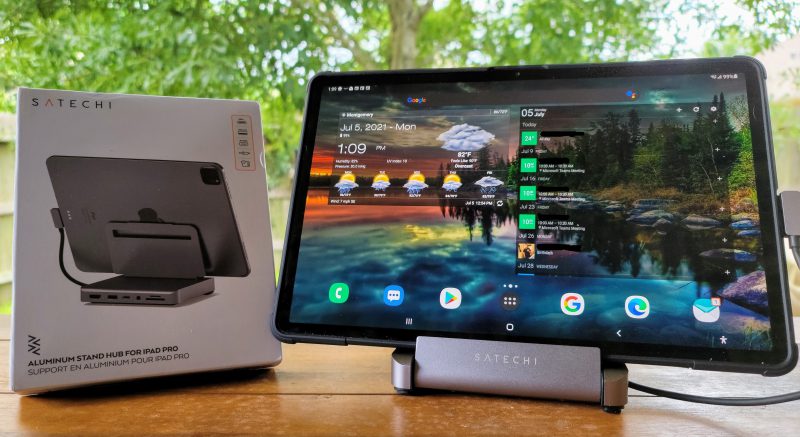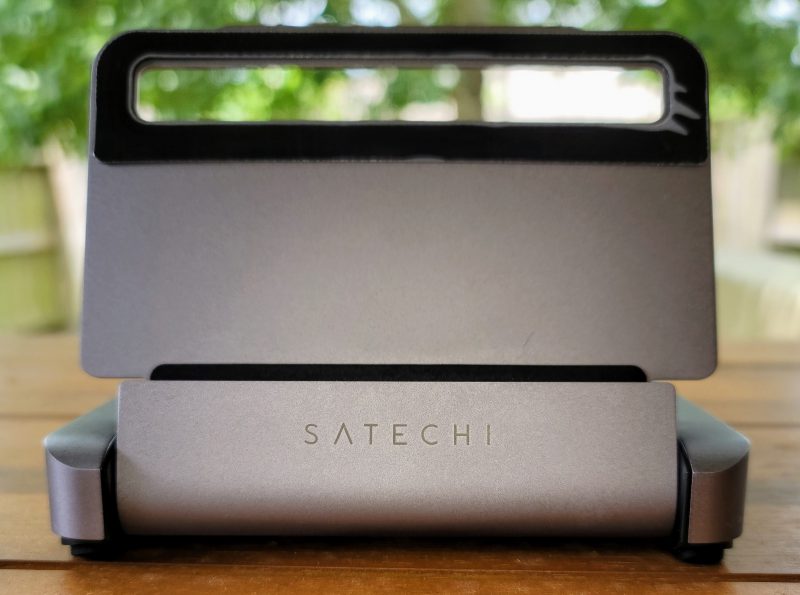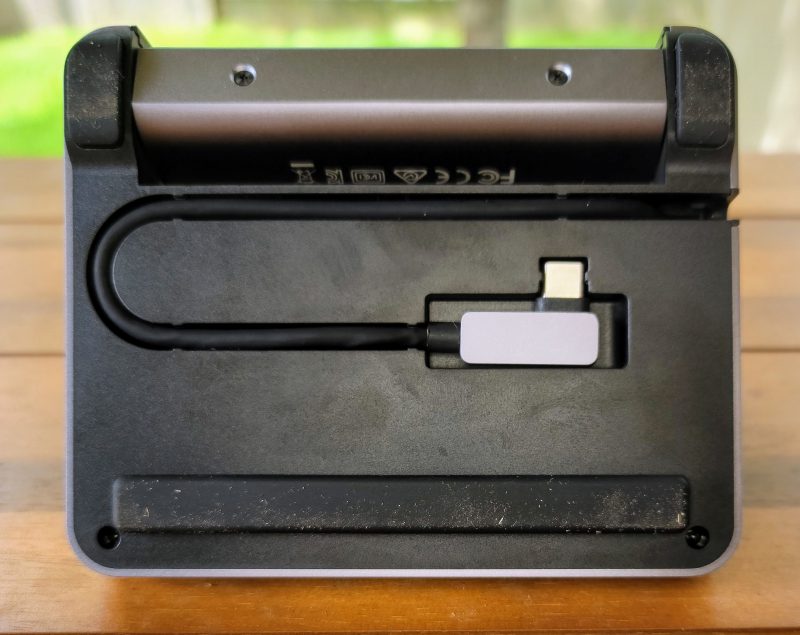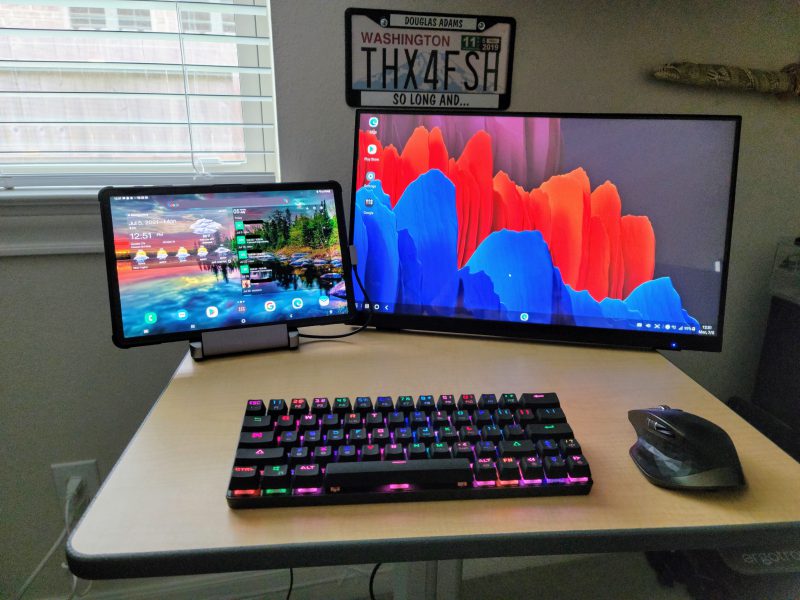
REVIEW – Question: when is a tablet not a tablet? When it becomes a workstation. That’s the goal of the Satechi Aluminum Stand Hub for iPad Pro (more on the post “for” in a moment). The first question inevitably leads to the next questions – why would you want to do that and is it worth the cost? Read on for the answer to this and to uncover some additional truths about this stand…
What is it?
The Satechi Aluminum Stand Hub for iPad Pro is essentially a docking station for your tablet, much like a docking station you might use with your laptop. It requires a USB-C connection to the tablet (sorry/not sorry, iPad Air and Mini owners!) and extends your tablet by adding an HDMI v2 port capable of driving a 4k monitor at 60HZ, a USB 3 type A port for data transfer (a thumb drive or other external storage), a USB-C Power Delivery port that can handle up to 60 watts, a 3.5mm audio jack and slots for both an SD and micro SD card. The PD port on the back can simultaneously charge your tablet and support the power requirements of older storage mediums (like spinning hard disks).
What’s in the box?
- Satechi Aluminum Stand Hub and attached USB-C interface cable
- A user manual and a safety guide
Design and Features
Just like any standard desktop stand, the Satechi has a cradle to hold the device. There are soft rubber pads wherever the stand comes into contact with your tablet to protect the finish of the tablet. Note in the picture below on the upper rubber pad the marks on the right side. This is not a fault of the tablet stand, but rather of the reviewer. I failed to take the protective plastic strip off the top of the pad and this is where the plastic had pulled away from the rubber.

The rear of the stand is where all the action happens – it is the home of the various ports the stand brings to the table. Starting on the left, you have the HDMI port, then the USB 3 type A port, the USB-C PD port, the 3.5mm audio jack and finally the micro SD and SD card slots stacked over.

When not in use, the attached USB-C interface cable folds neatly into the base. The stand portion folds over top of the base and protects the cable. That plus the 10 oz. weight make it a very capable traveling companion, although as you will see a little later, I think there is a much better use case for this stand. There are rubber feet on the stand portion as well as the back of the base to raise the stand slightly. The interface cable is about 8 inches long, so it should connect with even the larger sized iPad Pro or a device like the Microsoft Surface Pro 7.

How does it work?
Looking at the pictures, one might think the stand was designed for travel. Maybe it was – the size and weight lend themselves well, but sometimes it can be difficult to find a larger screen to plug into in your average hotel room. I don’t know about you, but the thought of lugging a monitor around as well seems at odds with this use case.
I would argue that the sweet spot for this stand is in the conversion of your tablet into a workstation. Before you say it – I know, there are plenty of keyboard covers on the market that have a similar price tag, and that at 12.9 inches the larger iPad Pro is a plenty big screen. But there are times when I want to get something done and typing on a miniature keyboard and using a trackpad to get around the screen just doesn’t cut it. Then there are people like my wife who have entirely ditched the laptop and live on her tablet. She has a cute little Bluetooth keyboard to type on, but sometimes misses the convenience of a full on workstation.
Here’s where the “for iPad Pro” part of the title comes in. It isn’t just. As in, this stand will support pretty much any device with a USB-C PD port. So far I’ve tried this with the following devices, and have had 100% success with each and every one:
- Apple iPad Pro (pre-M1)
- Samsung Galaxy Tab s7+
- Samsung Galaxy Note 20 Ultra
- Microsoft Surface Pro 7
- Microsoft Surface Book 3
Okay, to be fair that last one did not fit on the stand – I used the interface cable to plug into the USB-C port and just left the stand empty. And the power supply did not actually charge while in use, but it did slow down battery consumption. So maybe not the greatest application on the Surface Book 3, but the gist of this is that the stand should work with a very wide variety of devices. Don’t take the “for iPad Pro” as the only way to use this.
So how well does this fit the workstation use case? Well enough for me to be typing this review on it, pictures and all. Here is a glimpse of my setup:

In the stand sits my Samsung Galaxy Tab S7+. Connected to the stand is my power supply (I have the 45 watt fast charger – if you are going to connect power hungry devices to the USB-A port, I would suggest using something larger than the stock charger that comes with your device) which is keeping my tablet topped off at 100% and a thumb drive with various files. At the other end of the HDMI cable is a Planer 22 inch 1080p monitor running at 60HZ. Connected via Bluetooth is a Logitech MX Master 2 mouse and a Dierya DK-63 mechanical 60% keyboard. And it all sits on the fantastic Egrotron Mobile Sit/Stand Desk.
FYI – in setting this up, I also learned that you can use it with full functionality without plugging into a power source. Sure, it could drain your battery faster in your tablet, but it works powered or otherwise.
The tablet is in Samsung’s DeX mode – this is a piece of software on high-end Samsung devices which brings a Windows-like interface to the device. DeX makes it much easier to multitask and the convenience of having a browser window open next to Microsoft Word as you do research is invaluable.
So, getting back to writing the review on this setup, as I near the end I have found this to be a fantastic arrangement. The Satechi stand facilitates this setup but doesn’t introduce bugs or hiccups as some devices do. The entire process from initial setup to full functionality was smooth and took a matter of minutes. And I’ve been able to type at full speed throughout the writing of this review, something I could never manage on the smaller folio style keyboards.
What I like
- How easy it is to get productive with the stand
- It works pretty much everywhere, and consistently well at that
- It is small and lightweight in case I ever want to take this on the road
What I’d change
- Maybe make a deluxe version of this stand that articulates like the stand on the Microsoft Surface Studio – nice, but not a deal-killer
Final Thoughts
When I was offered the opportunity to review the Satechi stand, I was interested but wasn’t optimistic it would be a great device. I’ve seen a lot of manufacturers promise basic functionality but fail to deliver. For example, one company produced a device that looked like a laptop and was designed for just this workstation case, but no matter the power source plugged into it, I could literally watch my battery drain while using it – and that with a supposed battery in the clamshell that should have at least kept me at status quo for a while.
Satechi has knocked this one out of the park, though. It does what the box says it will do, it does it well, and it does it on far more devices than the name of the product would suggest. I like what this brings to my tech table so much that I’ve decided to leave this as a permanent installation on my mobile desk for my wife and I to share. We can pull this out onto the patio to have morning coffee and get some work done, or roll it into the living room to plan a vacation without having to constantly share links – we can look at the same screen at the same time without me having to constantly put on reading glasses.
At $99.99 the Satechi stand is probably mid-market price-wise for the kind of device it is. On the other hand, the functionality and reliability it sports moves it to the top of the market. If you are looking to make your on-the-go device a work from home one, too, then the Satechi Aluminum Stand Hub for iPad Pro (but not just for) is the stand to buy.
Price: $99.99
Where to buy: Direct from Satechi or at Amazon
Source: The source for this review was provided by Satechi


